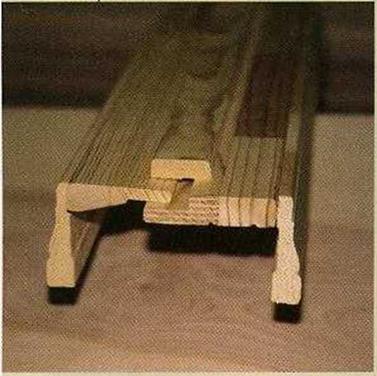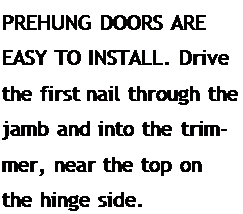STEP2 Install the Interior Doors
Once the underlayment is down, start installing the prehung doors. I have lived in older houses that required work on sticky doors, misaligned locks, and squeaky hinges. Quality doors open and close with ease even after years of use—if you take the time to install them with care. Remember that doors and jambs should last for the life of the house. That won’t happen if you buy junk. Doors and trim are finish work and are seen and used on a daily basis, so try to buy units that are both attractive and durable (see the side – bar on p. 244).
The first step in setting prehung doors is lo check the plans and see which way they open into a room. It’s helpful to set each door near its opening before nailing any of them in place. This should eliminate installing the wrong door in an opening. Whichever style
of prehung door you have, the installation process is basically the same. If the floors will be carpeted, put а Уь-іп.-thick block of OSB or plywood (V in. wide by 1 in. long) under each jamb side. The block will be hidden once the floor is carpeted. Otherwise, unless you have ordered shortened doors, you may have to trim the bottom of the door so it won’t drag on the carpet. The block, especially important when setting a heavy door, keeps the door assembly from settling, causing the door to stick.
Professional trim carpenters often order shortened doors from the supplier. That allows them to set the jambs right on the subfloor without having to raise them for carpeting. There is no need to buy shortened doors for thin vinyl floors. Check to see what other builders are doing in your area.
If a door is to work properly, its jamb needs to be set plumb, square, straight, and cross-sighted (both side jambs parallel to, or





THE STANDARD INTERIOR DOOR used in most affordable homes is 32 in. wide and has a flat, smooth plywood "skin" that covers a hollow core. But instead of settling for standard hollow-core doors, I recommend shopping around for some frame-and-panel doors made from solid wood. Doors can be a source of beauty in your house, and it may
be worth the extra cost to have some well-crafted doors in your favorite doorways. Check with one or more local suppliers, and look at the array of doors that are available. Sometimes, styles are discontinued or doors are special – ordered but never claimed. When that happens, you can find a great door at a bargain price.
Most doors open into rooms rather than into a hallway. They seldom open into closets. They can swing either to the right or to the left. The swing,
or hand, of a door can be confusing (see p. 157).
Make sure when you order doors that you and your supplier are both on the same page. Most house plans show which way the doors swing, so it’s not a bad idea to take the plans with you when you order doors.
Different styles of prehung doors are used in different parts of the country.
I like split-jamb, prehung doors, because they come with the trim (casing) installed, and they adjust for uneven wall thicknesses (see the photo at left). Another type of prehung door has a knockdown jamb. It comes in three pieces and also has the casing installed. A third style of prehung door has just the jambs but no casing (see the photo above).
After the jambs have been nailed in place, the casing must be cut and nailed around them.
in plane with, each other), so pay attention to the steps in the sidebar on the facing page. Remove any nails or plugs installed at the factory to hold the jamb and door together. Set the prehung assembly in the opening, and drive a 6d or an 8d finish nail through the jamb, about 3 in. or so from the top on the hinge side (see the photo at left).
With any luck, the trimmer on the hinge side will be plumb and you can nail the jamb directly to it without the use of shims. Use a 4-ft. level to check the hinge-side jamb for plumb and straight. Make sure the margin between the underside of the head jamb and the top of the door is at least % in., about the
|
|






Leave a reply